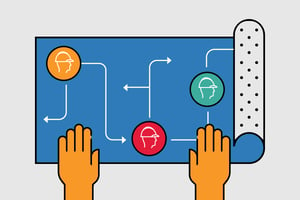During and after an emergency, your team needs to know how to respond. The first several steps taken can keep employees safe and reduce overall harm. Once disaster strikes, your team needs to know what to do and where to go, how to keep certain areas safe and how to prioritize their actions.
Review the below checklist to ensure that you emergency response plan has steps in place to manage employees, keep them safe and remove the most critical risks to your facility after an emergency.
Employee Management
- Are essential employees aware of their roles when an emergency happens?
- Do you have a master list of all employees on shift in order to account for employees during an emergency?
- Is this list regularly updated and maintained?
- Are designated leaders for employee safety named in the plan?
- Do you know who is responsible for locating and tracking employees during an emergency?
- Do employees know how to find out if they are needed onsite during an emergency?
- Are all employees trained to respond to the most common emergencies like spills and injuries?
Establishing Safety
- Does your plan designate safe zones where employees should meet after an emergency?
- Is this plan tested regularly so that employees act swiftly to get to the safe zone?
- Are levels for onsite toxic materials or waste tested regularly against known safe limits after an emergency?
- Do you have a plan in place to ensure employees are safe if these limits are passed?
- Do you have designated evacuation zones for employees?
- Does your plan include contact information for relevant emergency agencies?
Prioritizing Response
- Does your plan include specific guidance as to which should be the first sites/equipment to bring back online?
- Is the entire facility prioritized, so that repair teams know where to work first?
- Are specific steps outlined to guarantee employee safety, then to bring power back online and, finally, to restore capacity?
- Are plans in place to mitigate flooding, damage and leaking in hazardous waste and gas storage sites?
- Are power backups available, and is specific guidance provided on restoring power to core operations?
- Do employees have an easy way to flag new risks that appear during and after an emergency?
Please note this list is not comprehensive of all of the steps you may need to take to respond to emergencies, but each question can and should be answered as part of your plan.
The information contained in this article is intended for general information purposes only and is based on information available as of the initial date of publication. No representation is made that the information or references are complete or remain current. This article is not a substitute for review of current applicable government regulations, industry standards, or other standards specific to your business and/or activities and should not be construed as legal advice or opinion. Readers with specific questions should refer to the applicable standards or consult with an attorney.










Leave a Reply
Comment policy: We love comments and appreciate the time that readers spend to share ideas and give feedback. However, all comments are manually moderated and those deemed to be spam or solely promotional will be deleted.